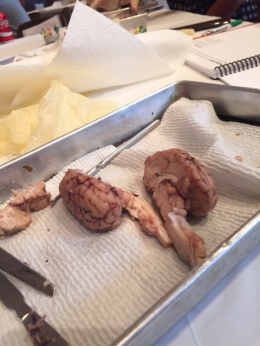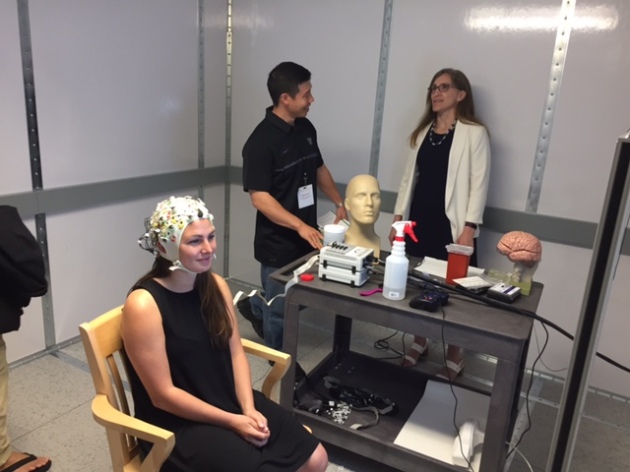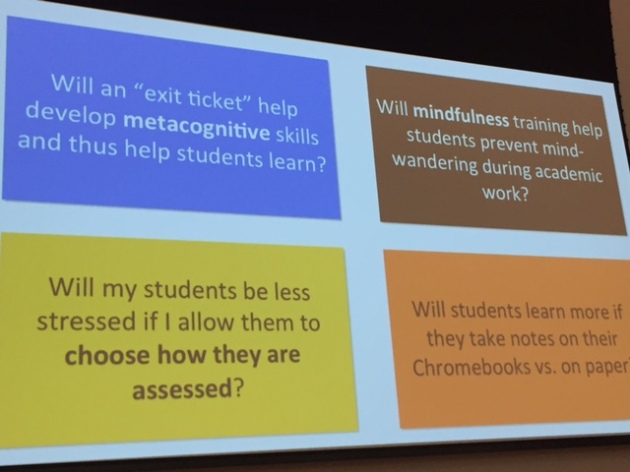In July, several teachers from Mount Vernon Presbyterian School had the honor to attend the CTTL Academy at Saint Andrew’s Episcopal School in Potomac, Maryland. In the week, we had many varied experiences from the discomfort of dissecting a brain (!) to designing an action research project to take back to our schools. Brains are not fixed – they are an information processing center that can grow and provide new neural pathways to deeper learning with purposeful emphasis.

A sheep’s brain helped us better understand the anatomy of a brain
The conference was the inaugural gathering and included many of the most innovative schools in the United States as well as across the globe. In whole group sessions, small group challenges, breakout discussions, deep dives into choice topics, and visits with Johns Hopkins education researchers, we broke down the process of learning to it’s building blocks within the brain to better understand and reach those we learn with in our classrooms.

Researchers demonstrate the activity in the brain by modeling the type of research they do at Johns Hopkins.

This “toy” from the 80’s actually works the way an EEG does! However, I think I will lobby to purchase the $100 EEG cap!
The staff of SAES, presenters and facilitators did an outstanding job with logistics, hospitality and planning! I believe that Neuroplasticity is not simply a flavor of the week buzzword in education. When we teach students how their brain works, they will recognize growth in learning – the journey, not just the grade – something we ALL are hoping for!
I am eager to put to work this year some of the key takeaways and watch my students grow as they never have before! Below are my notes from the conference.

Here are just some of the many research questions we pondered throughout the week.
MBE Power Strategies
Mind-Brain-Education seems like a redundant phrase, for who is not using their brain during the process of education and learning? The clear takeaway is that we must impart what the research says to answer the question How do we learn? – to the very minds in our care each day.
Neuroplasticity shows us that we can change our brains through practice. We can build new neural pathways. Build Metacognition: Thinking about thinking.
Through a simple participation exercise, demonstrated in 4 similar ways by different researchers, we learn that the brain transfers information that has MEANING to long term memory. All other new material, or even re-exposure to familiar material, is relegated to be forgotten.
Teach and assess in multiple modalities:
Spacing and interleaving has much better outcomes for long term learning. This is opposed to learning in “blocks” and being assessed on blocked information.
What we can expect is struggle during the formative assessments but higher levels of master when the summative assessments are given.
The best example given was in math – practice and tests should be given with types of problems mixed up, this way, the student must determine the strategy to be applied, and not just follow the ”rote” formula for that problem set.
As far as the format assessments go, they should be frequent for low stakes or no-stakes to reduce anxiety. (Some ideas were kicked around such as letting the student choose whether or not to count a small quiz, or let the choose a certain number to count.)
Move beyond lecture:
Direct teaching has its place.
Solo work helps ss focus, allows tailored work, and individual support
Try 10 things that are true or false about ——- to engage and evaluate prior knowledge
Lecture build a common foundation from which all will learn – where will it go from there? Follow up with an immediate opportunity to USE the content.
Try “buying” lecture time – I need your focus for 10 minutes –
“sketch it” after a lecture
Connect Class to students’ daily lives
Noted that there is very little research about whether empathy improves motivation
Incorporate the idea of justice, but make SURE it is taught as more than a black or white dichotomy, there is room for many ideas along the continuum
Acknowledge SS limited working memory
We way overestimate students working memory . Need to fully dissect an activity before the kids do it – they may not be able to “get it” without scaffolds
Think about the barriers that will hinder student performance and how you will eliminate them. Plan scaffolds and how you will peel them back way in advance.
Our goal is that students will develop and call on strategies.
Mnemonic, models, good examples to help limited working memory
Include choice and play – make it fun!
Team games, individual competitions, breakouts, google dance your phd, playspend.org for advisory, Factitious – for real or fake news, learn to evaluate sources.
*** Aid Memory – the Spacing and Interleaving Effect ***
Getting what we teach to stick better
Blocking vs. interleaving
spacing has the most supportive research. Teach how to space out studying and practice.
Study on taxi cab drivers in England – Blocking is like being on cruise control, you don’t have to think a lot. Interleaving is like stop and go traffic – you have to always be ready.
Research _ the interleaving group did worse at practice but better on overall test. The more times you walk the better you can find the path again. The brain builds strong connections over multiple times practicing, thinking about how the problems differ. Practicing multiple skills together the brain gets better at figuring out which type of problem it is and how to attack it.
Discussion : how is this similar and different to spiraling content?
Aid Memory – Formative Assessment and the Testing Effect
Students overestimate how well they know content
Frequent testing and self-testing words. RE-reading does not!
Spend time on the process of self testing.
After giving a formative assessment, tell students what you are going to do next based on the results. Ss should self-track where they are with content knowledge
Even kahoot, quizlet, quia, go formative all count as practice testing!
Give Feedback that works
Specific – timely – process focused -( mastery oriented)
Feedback should always lead to action, otherwise, why give it? Students should give self error analysis.
Try this – 1:1 mini conference with students along the way with feedback. (After you have established a good relationship and a safe classroom climate.) DO NOT give grade – based on the feedback I gave you, what grade do you think you earned?
Teach HOW to give feedback and how to receive it.
Keep feedback iterative – give it piece by piece. Not a whole long overwhelming list.
Break the mindset that you give them something, they fix it, then they get the A (grade effort and growth)
Student stories –
A dozen or so middle and high school students, as well as recent graduates, gave brief presentations to small groups about their learning journey. Here are some takeaways from the 3 I talked to – rising 7th, 9th and senior.
They loved…..fun, enthusiastic teachers, caring teachers, when Ts spent time on a relationship and getting to know them, grace, Knowing when other emotional stuff is going on in their life. re-enactments, group projects, hands on, feedback, having space to ask questions, and balance of fun and strict (keeping order). Relevant projects,
Disliked: Being treated like a little kid, teachers who did not deal justly with misbehavior (allowed disruptions), class being punished for actions of one, when T does the same thing every time. Meaningless HW or lots of HW, irrelevant work. Mean teachers, too strict makes it an environment where you feel you can’t ask questions. Dislike group grades.
They had difficulties with time management and switching schools was also hard.
Build a relationship and safe classroom environment by sharing stories about yourself. Builds understanding and connection.
Use humor and banter. don’t have every interaction be about their work!
Build Metacognition
We need to be teaching kids how their brain works. An EEG cap can demonstrate the recording of brain waves. Brains are changeable. Ts need to model metacognition. SAES logo on the shirts was “YET.” Do the activity that 3 of the researchers did with the educators – words or concepts that have meaning STICK. Turn negativity into YET statements.
Ask students if they had a disconnect with the content or how they interacted with it.
Focus on the strategies that research says REALLY works.
Try this – make a chart of concepts that you have mastered, then list the strategies that led to mastery.
Carol Dweck – how to encourage students
Beyond Growth Mindset
Students attribute their success or failure to 1. Inherited ability 2. Effort 3. Luck 4. Task Difficulty
MOTIVATION is closely related to how they attribute past successes or failures.
If reasons are internal, changeable, and within our control —> motivated
Students with FIXED mindset are not open to feedback. Create a culture of Ss wanting feedback! Ask them often if they want feedback.Help the lightbulb go off on feedback being desirable.
Help ss overcome learned helplessness, get parents on board.
Ask parents to partner with you on praising effort!
Video – Carol Dweck – how a growth mindset leads to higher achievement
Labels on kids imply fixed. Social and personality are also malleable.
Giving back tests: the ones with fixed mindsets look for someone who did worse than them, are not interested in the right answer.
How to help them change?
1.Direct teach: How brain changes in response to experience and practice.
2.Language: Have them explain connects to someone else can indirectly change beliefs. Affirm high standards.
3. Feedback: Give them strategies and remind them to use them! Give descriptive feedback. Allow revisions. Encourage help-seeking and collaboration. Grade them on trying something new. On rubrics, have one section for content and another for resilience. This works for behavior as well as for academics.
TRUST is important.
Make it Stick – a toolkit for students to improve learning and memory
How to remember better? How to retain better?
Force students to do active processing of information. Repetition and re-reading DOESN’T work! Student brains are being misled by familiarity and fluency. These are misleading cues! To Ss, new information learned seems arbitrary – need to build understanding. Have them give reason why, what if statements. Why is a great way to force thinking! Use explain and why questions from the very beginning. Ask, why would a teacher want to know this. Why do scientists classify this way?
—-> Exercise – generate a bunch of man sentences then do it again with Ss making a mental picture of each man. Show them how they need to make a connection to remember.
1. Have Ss prepare to teach someone else – mini writing or drawing – then explain to someone else.
For review, space it out.
Lead Ss to generate better questions, develop Qs to ask themselves during reading. Grade the WHY. CER – claim evidence reasoning.
2. Space Study and instruction
3. Mix it up! Interleaving. Blocked practice undermines what we desire – that Ss figure out strategies. Closely related concepts should be taught together so students can figure out similarities / differences
4. Retrieval practice
Feedback and Assessment
There is a feedback continuum – feedback with a grade is 50 % less effective!
Use feedback as scaffolding. Start the year with it one way, change how you give it and to what level. Feedback should be summarized, reduced and delayed by end of year.
EX: Instead of writing in all the periods, give feedback that student needs to work on ending sentences with proper punctuation ONCE, not a bunch of red marks. “Your —— is looking better but you need to work on.”

This group of MVPS learners can attest to the truth of neuroplasticity – we learned plenty of relevant information and strategies during our week of workshops and discussions!